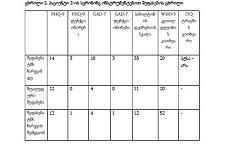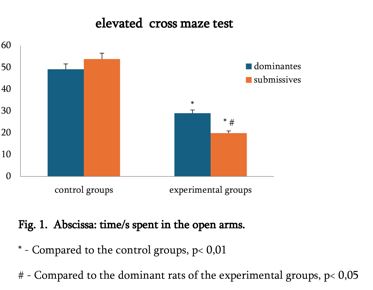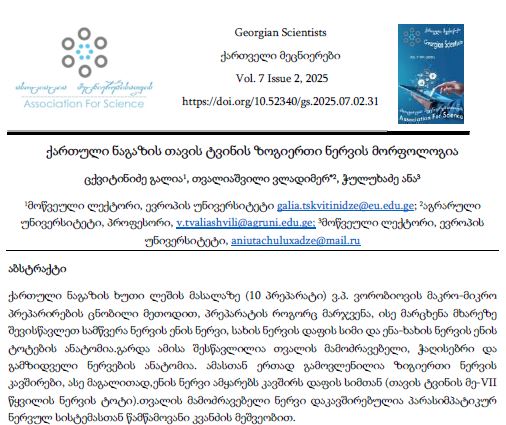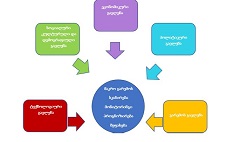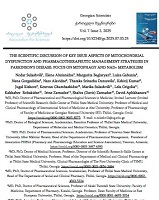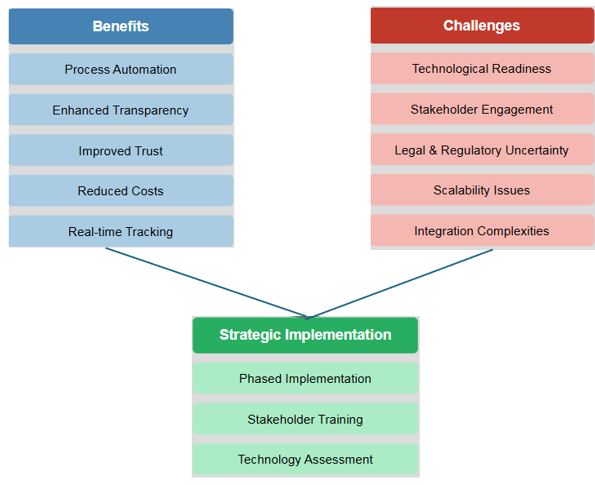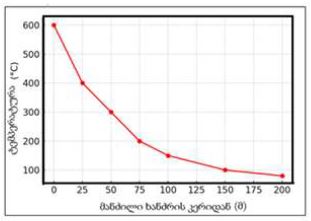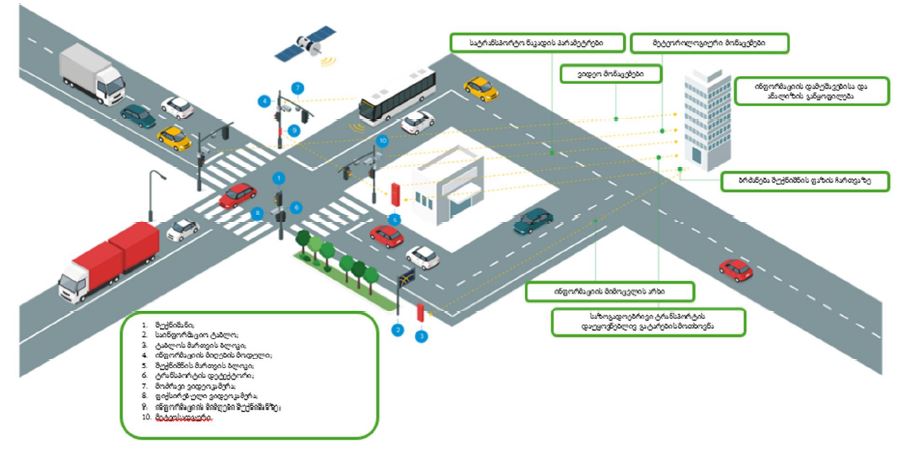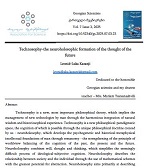TRITERPENE SAPONINS OF SOME PLANTS GROWING IN GEORGIA AND THEIR BIOLOGICAL ACTIVITY
Downloads
Triterpene saponins, which are widely distributed in the plant world, are characterized by versatile biological activity. They are characterized by diverse pharmacological activity including, but not limited to immunostimulating, antitumor, antimutagenic, anti-inflammatory. The study reports the results of chemical study of glycosides obtained the sum of purified saponins (PS-551) from Fatsia japonica and Bupleurum B.wittmannii Stev. and from B. rotundifolium and their anti-inflammatory activity. Glycosides content in F.japonica appeared 6.5%, in B.wittmannii Stev. - 3.4%, and in B.rotundifolium L. - 3.7%. Among the triterpene glycosides obtained from above-ground organs, saponins of the oleanol type were identified - saikosaponin A and saikosaponin C. In the model of carrageenan-induced edema in rodents, it was determined that all the investigated products exhibit a pronounced dose-dependent anti-inflammatory effect. In addition, the effective dose of glycosides of B.wittmannii Stev. was found to be twice more than that of B.rotundifolium and F. japonica, due to which B.wittmannii Stev. can be considered as a promising raw material rich in saikosaponins for the development of effective anti-inflammatory drugs.
Downloads
Kwon SY, Park JW, Young-Jae YJ. Effects of Korean red ginseng on cold- and heat-related symptoms and the autonomic nervous system. European J. of Integrative Medicine. 2015; 7:228-233. DOI: 10.1016/j.eujim.2015.01.004
Yamamoto M, Kumagai A, Yamamura Y. Structure and actions of saikosaponins isolated from Bupleurum falcatum L. I. Anti-inflammatory action of saikosaponins. Arzneimittelforschung. 1975; 25(7): 1021-3.,
Ginseng: Global Strategic Business Report. https://www.researchandmarkets.com/reports/5029877/
Abe H et al. Pharmacological actions of saikosaponins isolated from Bupleurum falcatum. 1. Effects of saikosaponins on liver function. Planta Med. 1980; 40(4): 366-372. DOI: 10.1055/s-2008-1074987.
Jia A, Yang X, Zou B, et al. Saikosaponins: A Review of Structures and Pharmacological Activities. Natural Product Communications. 2022; 17(5): 1–24. DOI:10.1177/1934578X221094908
Wagner H. Search for new Contituens with Potential Antiphlogistic and Antiallergic Activity. Planta med. 1989; 55(3): 235-241.
Hao M et al. Structure-activity relationship and substrate-dependent phenomena in effects of ginsenosides on activities of drug-metabolizing P450 enzymes.nPLoS One. 2008; 3(7):e2697. DOI: 10.1371/journal.pone.0002697
Kim BM. The Role of Saikosaponins in Therapeutic Strategies for Age-Related Diseases. Oxid Med Cell Longev. 2018; 8275256. DOI: 10.1155/2018/8275256
Ye X, Yu S, Lian XY, Zhang Z. Quantitative determination of triterpenoid glycosides in Fatsia japonica Decne. & Planch. using high performance liquid chromatography. J Pharm Biomed Anal. 2014; 88: 472-476. DOI: 10.1016/j.jpba.2013.09.017.
Soldati F, Sticher O. HPLC Separation and Quantitative Determination of Ginsenosides from Panax ginseng, Panax quinquefolium and from Ginseng Drug Preparations. Planta Med 1980; 39(8): 348-357. DOI: 10.1055/s-2008-1074929
Guide for the Care and Use of Laboratory Animals, 8th Ed. USA: the National Academies Press: 2011.
Directive 2010/63/EU on the protection of animals used for scientific purposes. Official Journal of the European Union, L 276/33, 2010.
Morris CJ. Carrageenan-Induced Paw Edema in the Rat and Mouse. In: Inflammation Protocols. Humana Press. 2003; 225:115-112
Ma, Y., Bao, Y., Wang, S. et al. Anti-Inflammation Effects and Potential Mechanism of Saikosaponins by Regulating Nicotinate and Nicotinamide Metabolism and Arachidonic Acid Metabolism. Inflammation. 2016; 39:1453–1461 DOI: 10.1007/s10753-016-0377-4
ზურაბ ქემოკლიძე - ფარმაციის დოქტორი, თსსუ იოველ ქუთათელაძის ფარმაკოქიმიის ინსტიტუტის უფროსი მეცნიერ თანამშრომელი, საქართველო, თბილისი, E-mail: z.qemoklidze@tsmu.edu
მარინე სულაქველიძე - თსსუ იოველ ქუთათელაძის ფარმაკოქიმიის ინსტიტუტის უფროსი მეცნიერ თანამშრომელი, საქართველო, თბილისი, E-mail: m.sulakvelidze@tsmu.edu
ჟანა ნოვიკოვა - თსსუ იოველ ქუთათელაძის ფარმაკოქიმიის ინსტიტუტის მეცნიერ თანამშრომელი, საქართველო, თბილისი, E-mail: z.novikova@tsmu.edu
კარენ მულკიჯანიანი - თსსუ იოველ ქუთათელაძის ფარმაკოქიმიის ინსტიტუტის მთავარი მეცნიერ თანამშრომელი, საქართველო, თბილისი, E-mail: k.mulkijanyani@tsmu.edu
Zurab Kemoklidze1 - Doctor of Pharmacy, Senior Researcher, Iovel Kutateladze Institute of Pharmacochemistry, Tbilisi State Medical University, Tbilisi, Georgia, E-mail: z.qemoklidze@tsmu.edu
Marina Sulakvelidze 2 - Senior Researcher, Iovel Kutateladze Institute of Pharmacochemistry, Tbilisi State Medical University, Tbilisi, Georgia, m.sulakvelidze@tsmu.edu
Zhana Novikova3- Researcher, Iovel Kutateladze Institute of Pharmacochemistry, Tbilisi State Medical University, Tbilisi, Georgia, z.novikova@tsmu.edu
Karen Mulkijaniani 4-Principal Researcher, Iovel Kutateladze Institute of Pharmacochemistry, Tbilisi State Medical University, Tbilisi, Georgia, k.mulkijanyani@tsmu.edu

This work is licensed under a Creative Commons Attribution-NonCommercial-NoDerivatives 4.0 International License.





















